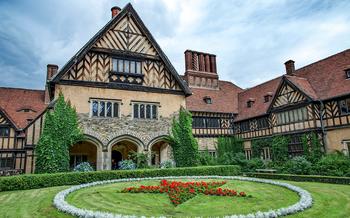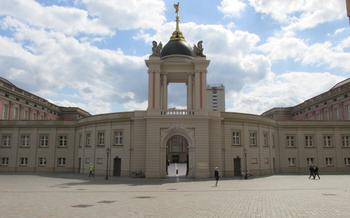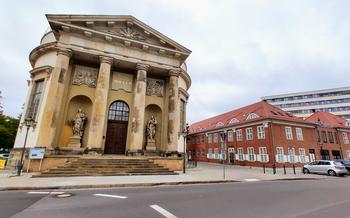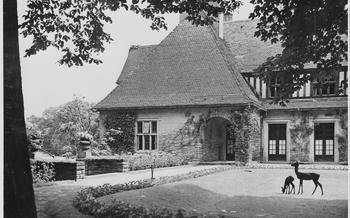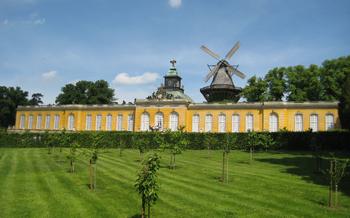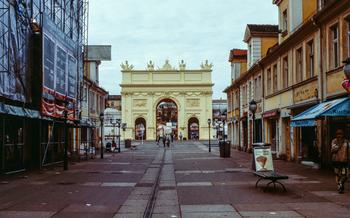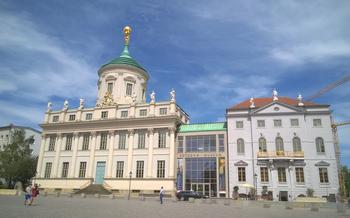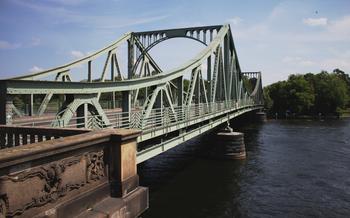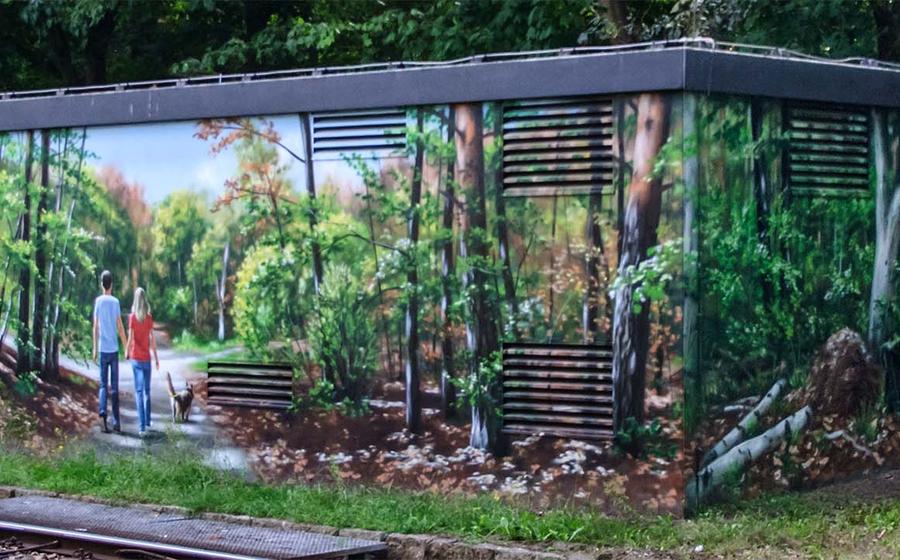
The Lindenstraße 54 Memorial Site
- The Lindenstraße 54 Memorial Site: A Place of Remembrance
- Honoring the Victims of Lindenstraße 54
- Preserving the Memory of Lindenstraße 54
- Exploring the Memorial Site's Exhibitions
- Reflecting on the Legacy of Lindenstraße 54
- Visiting the Lindenstraße 54 Memorial Site
- The Memorial's Educational Programs
- The Memorial's Cultural Events
- The Memorial's Research and Documentation Center
- The Memorial's International Outreach
- The Memorial's Impact on Society
- Personal Stories and Testimonials
- The Memorial's Future Plans
- Insider Tip: Hidden Gems of the Memorial Site
The Lindenstraße 54 Memorial Site: A Place of Remembrance
The Lindenstraße 54 Memorial Site in Potsdam, Germany, stands as a solemn testament to the dark chapter of history that unfolded within its walls during the Soviet occupation following World War II. Once a military prison, Lindenstraße 54 witnessed unspeakable horrors and human suffering. Today, it serves as a powerful memorial site, educating visitors about the atrocities committed and honoring the victims who perished within its confines.
The memorial site's significance extends beyond its historical importance. It plays a crucial role in promoting remembrance, reconciliation, and education. Through its exhibitions, educational programs, and research initiatives, the Lindenstraße 54 Memorial Site seeks to ensure that the memory of the victims is preserved, and the lessons of the past are never forgotten.
Visiting the memorial site offers a profound and moving experience. Visitors can explore the permanent and temporary exhibitions, participate in guided tours, and engage with interactive displays that bring the history of the site to life. The memorial site also hosts commemorative events and ceremonies, fostering a sense of community and remembrance among visitors, survivors, and their families.
Honoring the Victims of Lindenstraße 54
To honor the victims of Lindenstraße 54 and preserve their memory, several initiatives have been undertaken. In 1994, the memorial site was established, transforming the former prison into a poignant place of remembrance. Commemorative events and ceremonies are held regularly to pay tribute to those who suffered and lost their lives within these walls. Extensive research and documentation efforts are ongoing, meticulously piecing together the history of the site and the individual stories of the victims. Educational programs and exhibitions further contribute to the memorial's mission of educating visitors about the atrocities committed during the Soviet occupation. Through these initiatives, the Lindenstraße 54 Memorial Site serves as a powerful reminder of the human cost of war and oppression, while honoring the resilience and dignity of those who endured unimaginable suffering.
Preserving the Memory of Lindenstraße 54
The Lindenstraße 54 Memorial Site holds immense architectural significance as a tangible reminder of the atrocities committed during the Soviet occupation of Germany. Efforts have been made to restore and conserve the site to maintain its authenticity and ensure its preservation for future generations.
The restoration process involved meticulous attention to detail, respecting the original architectural features and materials. The buildings have been carefully renovated to their original state, preserving their historical integrity. The grounds surrounding the memorial have also been restored, creating a serene and contemplative environment that complements the site's somber history.
Maintaining the grounds and facilities at Lindenstraße 54 is an ongoing effort to ensure that the memorial remains a dignified and respectful place for remembrance and education. Regular upkeep and maintenance tasks are carried out to keep the site in pristine condition. Accessibility for visitors has been a key consideration, with designated pathways, ramps, and facilities for individuals with disabilities. The memorial strives to create an inclusive environment where everyone can comfortably access and explore the site.
Exploring the Memorial Site's Exhibitions
The Lindenstraße 54 Memorial Site offers a range of exhibitions that provide visitors with a deeper understanding of the site's history and significance. The permanent exhibition, "Lindenstraße 54: A Place of Remembrance," presents a comprehensive overview of the site's history, from its use as a Soviet military prison to its transformation into a memorial. Through artifacts, documents, and personal accounts, the exhibition sheds light on the tragic events that took place within these walls.
In addition to the permanent exhibition, the memorial site also hosts temporary exhibitions on related topics. These exhibitions often focus on specific aspects of the site's history or explore broader themes related to human rights, remembrance, and reconciliation. Past exhibitions have addressed topics such as the experiences of women during the Soviet occupation, the fate of Soviet prisoners of war, and the challenges of transitional justice.
Visitors can explore the exhibitions at their own pace or join a guided tour. Guided tours are available in German and English and provide visitors with a deeper insight into the site's history and significance. Audio guides are also available for self-guided tours, offering visitors the flexibility to explore the exhibitions at their own pace and in their preferred language.
The memorial site also features a number of interactive displays and multimedia presentations. These interactive elements enhance the visitor experience by providing additional information and perspectives on the site's history. Visitors can watch historical footage, listen to audio recordings of survivor testimonies, and interact with touchscreens to learn more about the site's history and its ongoing legacy.
Reflecting on the Legacy of Lindenstraße 54
The Lindenstraße 54 Memorial Site serves as a powerful reminder of the atrocities committed during World War II and the importance of learning from the past to prevent such horrors from happening again. By preserving the memory of the victims and sharing their stories, the memorial contributes to fostering reconciliation, promoting understanding and tolerance, and addressing contemporary issues of human rights and social justice.
The memorial's educational programs and exhibitions shed light on the consequences of hatred, prejudice, and discrimination, encouraging visitors to reflect on their own attitudes and behaviors. Through workshops, seminars, and guided tours, the memorial provides a platform for dialogue, critical thinking, and empathy, fostering a sense of global citizenship and responsibility.
The memorial's legacy extends beyond its physical boundaries, inspiring action and advocacy for human rights and social justice. By raising awareness of the past and promoting tolerance and understanding, the memorial contributes to creating a more just and equitable society. It serves as a reminder that vigilance is necessary to prevent the repetition of past mistakes and that the fight for human rights is an ongoing struggle that requires the active participation of all members of society.
Visiting the Lindenstraße 54 Memorial Site
The Lindenstraße 54 Memorial Site is easily accessible by public transportation. Take the tram or bus to the Lindenstraße/Havelchaussee stop, which is just a short walk from the memorial site. The memorial is open to the public from Tuesday to Sunday, with guided tours available in English and German. Admission is free of charge.
Guided tours provide a deeper insight into the history of the site and the experiences of the prisoners held here. Visitors can explore the preserved prison cells, learn about the conditions the prisoners faced, and hear personal stories of those who survived. Educational programs are also offered for schools and groups, providing an opportunity for students to engage with the history of Lindenstraße 54 and its relevance to contemporary issues of human rights and social justice.
The memorial site offers various amenities for visitors, including a visitor center with a café, restrooms, and a gift shop. There are also several benches and seating areas throughout the grounds, allowing visitors to take a moment to reflect on the site's history and its significance. The memorial is wheelchair accessible, with ramps and elevators providing access to all areas of the site.
The Memorial's Educational Programs
The Lindenstraße 54 Memorial Site offers a range of educational programs designed to engage students of all ages and foster a deeper understanding of the site's history and significance. These programs are tailored to different grade levels and curriculum requirements, providing an immersive learning experience that combines historical knowledge with critical thinking and empathy.
Workshops and seminars allow students to delve into specific aspects of the memorial's history, such as the conditions for prisoners, the execution methods, or the post-war investigations. Through interactive activities, discussions, and presentations, students gain a comprehensive understanding of the events that transpired at Lindenstraße 54 and their broader implications.
Teacher training and resources are provided to equip educators with the knowledge and tools needed to effectively teach about the memorial and its history. Training sessions cover topics such as the site's historical context, educational methodologies, and the use of primary sources. Teachers are also provided with access to a range of resources, including lesson plans, handouts, and multimedia materials.
Educational materials and resources are developed by the memorial site to support teachers and students in their exploration of the site's history. These materials include educational guides, brochures, posters, and online resources that provide factual information, historical context, and interactive learning activities.
The memorial site also collaborates with schools and universities to develop joint projects and initiatives. These collaborations may involve student research projects, internships, or the development of educational programs and exhibitions. The memorial site's educational programs play a crucial role in ensuring that the memory of Lindenstraße 54 and the lessons it holds are passed on to future generations.
The Memorial's Cultural Events
The Lindenstraße 54 Memorial Site hosts a variety of cultural events to engage the public and promote remembrance, understanding, and reconciliation. These events provide a platform for dialogue, reflection, and artistic expression, enhancing the memorial's educational mission.
- Commemorative Events and Ceremonies:
-
Solemn ceremonies are held annually to honor the victims of Lindenstraße 54 and their families. These events feature speeches, wreath-laying, and readings, creating a space for remembrance and reflection.
-
Film Screenings and Discussions:
-
The memorial hosts film screenings related to the history of Lindenstraße 54, the broader context of the Soviet occupation, and human rights issues. Post-screening discussions with filmmakers, historians, and survivors foster a deeper understanding of the past and its relevance to contemporary society.
-
Lectures and Presentations:
-
Experts, scholars, and survivors are invited to give lectures and presentations on various topics related to the memorial's history, human rights, and the importance of remembrance. These events provide insights into the past and encourage critical thinking and discussion.
-
Art Exhibitions and Performances:
- The memorial collaborates with artists to create exhibitions and performances that explore themes of memory, loss, resilience, and human rights. These artistic expressions provide a creative and emotive lens through which to engage with the history of Lindenstraße 5
The Memorial's Research and Documentation Center
The Lindenstraße 54 Memorial Site houses a comprehensive research and documentation center dedicated to preserving and sharing the history of the site and its significance. The center serves as a valuable resource for scholars, researchers, and the general public alike.
The center's extensive archival materials include historical documents, photographs, and artifacts related to the Soviet military prison, the executions and burials, and the post-war investigations. These materials provide a rich foundation for research and understanding of this dark chapter in history.
Researchers and scholars are welcome to access the center's collections and conduct research on a variety of topics related to the memorial site. The center's staff is available to assist with research inquiries and provide guidance to researchers.
In addition to its archival holdings, the center also conducts its own research projects and publishes scholarly articles and books on the history of the Lindenstraße 54 Memorial Site. These publications contribute to the broader understanding of this important historical site and its significance for contemporary issues of human rights and reconciliation.
The research and documentation center also collaborates with other institutions and organizations to promote research and scholarship on related topics. This collaboration includes hosting conferences and workshops, sharing research findings, and developing educational materials.
Through its research and documentation efforts, the Lindenstraße 54 Memorial Site contributes to the preservation of historical memory, the promotion of understanding and tolerance, and the fight against intolerance and discrimination.
The Memorial's International Outreach
The Lindenstraße 54 Memorial Site actively engages in international outreach to promote remembrance, education, and understanding on a global scale. Through collaborations with other memorials, museums, and educational institutions worldwide, the memorial fosters a network of shared knowledge and experiences.
Educational exchanges and partnerships play a crucial role in this international outreach. The memorial collaborates with organizations in various countries to facilitate the exchange of ideas, best practices, and research findings. These collaborations often result in joint projects, exhibitions, and educational programs that reach a broader audience.
Participation in international conferences and events provides the memorial with a platform to share its work, engage with experts and stakeholders from different countries, and contribute to global discussions on remembrance, human rights, and social justice.
To ensure that the memorial's message reaches a diverse audience, translation of materials into multiple languages is a key component of its international outreach efforts. This allows the memorial to connect with visitors and partners from various linguistic backgrounds, promoting inclusivity and accessibility.
Through these international collaborations and initiatives, the Lindenstraße 54 Memorial Site contributes to a global discourse on remembrance, human rights, and the fight against intolerance and discrimination. Its outreach efforts foster understanding, promote dialogue, and inspire action for social justice and human dignity.
The Memorial's Impact on Society
The Lindenstraße 54 Memorial Site has had a profound impact on society, both locally and internationally. It has played a crucial role in raising awareness of the tragic history of the site and the suffering endured by the prisoners held there. Through its educational programs, exhibitions, and research initiatives, the memorial has contributed to a deeper understanding of the past and the importance of remembrance.
The memorial has also been instrumental in promoting dialogue and understanding among people from different backgrounds and perspectives. By facilitating conversations about the history of Lindenstraße 54 and its relevance to contemporary issues, the memorial has helped to break down barriers and build bridges between people.
Moreover, the memorial has been actively engaged in the fight against intolerance and discrimination. By shedding light on the consequences of hatred and prejudice, the memorial has helped to raise awareness of the importance of human rights and social justice. It has also inspired many visitors to take action against discrimination and to promote understanding and tolerance in their own communities.
In short, the Lindenstraße 54 Memorial Site has made a significant contribution to society by raising awareness of the past, promoting dialogue and understanding, and inspiring action for human rights and social justice.
Personal Stories and Testimonials
Personal stories and testimonials play a crucial role in bringing the history of the Lindenstraße 54 Memorial Site to life. Survivors and witnesses of the Soviet military prison share their firsthand accounts, providing a deeply personal and human dimension to the site's history. These stories offer a glimpse into the lives of those who endured unimaginable suffering and loss. Oral history projects and documentaries capture these narratives, ensuring that the experiences of the victims are not forgotten. By sharing these personal stories, the memorial site humanizes the history and connects with visitors on a profound level, fostering empathy and understanding. Through these testimonials, visitors gain a deeper appreciation for the resilience, courage, and humanity of those who suffered at Lindenstraße 5
The Memorial's Future Plans
The Lindenstraße 54 Memorial Site is committed to preserving the memory of the victims and educating future generations about the horrors of war and tyranny. To this end, the memorial has several ongoing and planned initiatives:
-
Ongoing Research and Documentation Initiatives: The memorial's research team continuously works to uncover new information about the history of the site and the individuals who were imprisoned and executed there. This research includes archival investigations, interviews with survivors and witnesses, and archaeological excavations.
-
Expansion of Educational Programs and Resources: The memorial is expanding its educational offerings to reach a wider audience. This includes developing new educational materials, such as interactive exhibits, online resources, and teacher training programs. The memorial also plans to offer more workshops, seminars, and guided tours for students and the general public.
-
Development of New Exhibitions and Displays: The memorial plans to develop new exhibitions and displays to shed light on different aspects of the site's history. These exhibitions may focus on specific groups of victims, the conditions of imprisonment, or the post-war investigations and trials.
-
Collaborations with Other Institutions and Organizations: The memorial actively collaborates with other memorials, museums, and educational institutions to share knowledge, resources, and expertise. These collaborations include joint research projects, educational initiatives, and public events.
Through these ongoing and planned initiatives, the Lindenstraße 54 Memorial Site strives to ensure that the memory of the victims is preserved, the lessons of the past are learned, and future generations are inspired to stand up against injustice and oppression.
Insider Tip: Hidden Gems of the Memorial Site
Beyond the somber history and poignant exhibits, the Lindenstraße 54 Memorial Site offers visitors an opportunity to explore the surrounding area and discover hidden gems that enhance the overall experience. Take a stroll through the serene park and gardens adjacent to the memorial, offering a tranquil respite for reflection and remembrance.
Just a short distance away, the Babelsberg Film Studio beckons with its rich cinematic history and captivating tours. Step into the world of filmmaking and learn about the iconic movies produced within these legendary studios.
Venture further into the historic city of Potsdam, a treasure trove of cultural and architectural wonders. Explore the majestic Sanssouci Palace, marvel at the beauty of the UNESCO World Heritage-listed gardens, and immerse yourself in the vibrant art scene.
Complete your visit with a culinary adventure, savoring local delicacies at charming cafes and restaurants. Indulge in traditional German cuisine, sample fresh seasonal produce at the vibrant markets, or treat yourself to a delightful sweet treat at a local confectionery.
